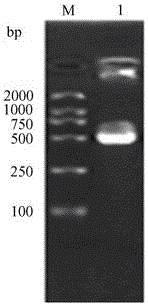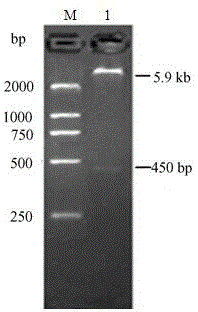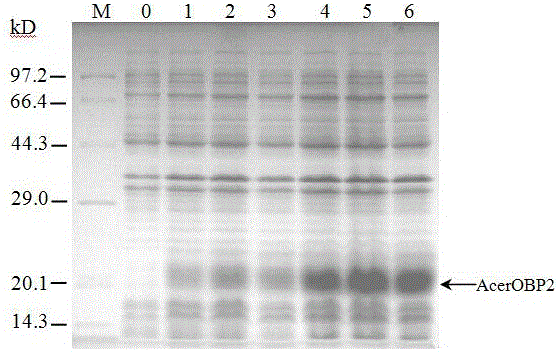Smell activator screening method based on apis cerana odorant binding protein
An odor-binding protein and technology of Apis cerana, applied in the field of bioengineering, can solve the problems of various and complex volatile components
- Summary
- Abstract
- Description
- Claims
- Application Information
AI Technical Summary
Problems solved by technology
Method used
Image
Examples
Embodiment 1
[0028] Example 1: Collection of total RNA from antennae of Apis cerana and gene cloning of odorant binding protein OBP
[0029] 1 Cloning of the odorant-binding protein AcerOBP2 of Apis mellifera
[0030] 1.1 Extraction of total RNA from Apis cerana
[0031] Trizol reagent was used to extract the total RNA of the antennae of Apis cerana workers, and the specific operation steps were as follows:
[0032] 1) Take out the preserved antennae samples of Apis chinensis worker bees from -80°C, put them into a mortar pre-cooled with liquid nitrogen, add liquid nitrogen to quickly grind, this step is operated on ice, and weigh 100mg after grinding into powder Put the tissue sample into a 1.5mL centrifuge tube, then add 1ml Trizol reagent, and mix on a vortex mixer;
[0033] 2) Let the sample stand at room temperature for 5 minutes to completely separate the nucleic acid-protein complex;
[0034] 3) 4°C, 12 000×g, centrifuge for 5 minutes;
[0035] 4) Transfer the supernatant to a n...
Embodiment 2
[0068] Example 2: Construction of the expression vector for the odorant binding protein AcerOBP2 of Apis mellifera
[0069] 2.1 PCR amplification of AcerOBP2 gene
[0070] The total RNA of Apis chinensis was extracted, the first strand of cDNA obtained by reverse transcription was used as a template, and the primers before and after primers of AcerOBP2 were designed and synthesized for PCR reaction, and the PCR results were subjected to agarose gel electrophoresis, as shown in figure 1 As shown in , the target fragment of about 447bp was obtained, which was consistent with the expected fragment length.
[0071] 2.2 Identification by double enzyme digestion
[0072] The target fragment obtained by PCR amplification of AcerOBP2 gene was recovered and purified by gel, ligated with pGEM-T easy Vector for transformation, and after identification of blue and white spots, the white clone was selected on the ampicillin-containing medium plate, inoculated and cultured, and the plasmid...
Embodiment 3
[0092] Example 3: Induced Expression of Apis mellifera Odor Binding Protein AcerOBP2
[0093] After verification, the single colony was cultured in 3 mL LB medium containing 100 μg / mL ampicillin with shaking at 37 ° C overnight, and inoculated into 20 mL LB medium with 1% (V / V) inoculum the next day to expand the culture to OD 600 At about 0.4, add IPTG to a final concentration of 1 mmol / L and start to induce expression at 30°C and 200 rpm. Take out 1mL of bacterial liquid every 1h, induce 5h in total, use the uninduced bacterial liquid as a negative control, after the end of induction, centrifuge the bacterial liquid collected every hour at 8000rpm for 10min, and use ddH 2 O were resuspended and centrifuged at 5000rpm for 10 minutes to collect the bacteria, add 150 μl of 1×SDS sample buffer to suspend the bacteria pellet, and boil in water at 100°C for 10 minutes to fully lyse the bacteria. 5% stacking gel and 12% separating gel were electrophoresed in SDS-PAGE to determine ...
PUM
 Login to View More
Login to View More Abstract
Description
Claims
Application Information
 Login to View More
Login to View More - R&D
- Intellectual Property
- Life Sciences
- Materials
- Tech Scout
- Unparalleled Data Quality
- Higher Quality Content
- 60% Fewer Hallucinations
Browse by: Latest US Patents, China's latest patents, Technical Efficacy Thesaurus, Application Domain, Technology Topic, Popular Technical Reports.
© 2025 PatSnap. All rights reserved.Legal|Privacy policy|Modern Slavery Act Transparency Statement|Sitemap|About US| Contact US: help@patsnap.com



